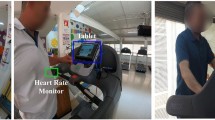Abstract
Social isolation in hospitals is a well established risk factor for complications such as cognitive decline and depression. Assistive robotic technology has the potential to combat this problem, but first it is critical to investigate how hospital patients react to this technology. In order to address this question, we introduced a remotely operated NAO humanoid robot which conversed, made jokes, played music, danced and exercised with patients in a London hospital. In total, 49 patients aged between 18–100 took part in the study, 7 of whom had dementia. Our results show that a majority of patients enjoyed their interaction with NAO. We also found that age and dementia significantly affect the interaction, whereas gender does not. These results indicate that hospital patients enjoy socialising with robots, opening new avenues for future research into the potential health benefits of a social robotic companion.








Similar content being viewed by others
References
Alemi M, Ghanbarzadeh A, Meghdari A, Moghadam LJ (2016) Clinical application of a humanoid robot in pediatric cancer interventions. Int J Soc Robot 8(5):743–759. https://doi.org/10.1007/s12369-015-0294-y
Belpaeme T, Baxter PE, Read R, Wood R, Cuayáhuitl H, Kiefer B, Racioppa S, Kruijff-Korbayová I, Athanasopoulos G, Enescu V, Looije R, Neerincx M, Demiris Y, Ros R, Beck A, Cañamero L, Hiolle A, Lewis M, Baroni I, Nalin M, Cosi P, Paci G, Tesser F, Sommavilla G, Humbert R (2012) Multimodal child-robot interaction: building social bonds. J Hum-Robot Interact 1(2):33–53. https://doi.org/10.5898/JHRI.1.2.Belpaeme
Block L, Habicht R, Wu AW, Desai SV, Wang K, Silva KN, Niessen T, Oliver N, Feldman L (2013) In the wake of the 2003 and 2011 duty hours regulations, how do internal medicine interns spend their time? J Gen Intern Med 28(8):1042–1047. https://doi.org/10.1007/s11606-013-2376-6
Demiris Y (2009) Knowing when to assist: developmental issues in lifelong assistive robotics. In: Proceedings of the annual conference of the IEEE engineering in medicine and biology society, pp 3357–3360. https://doi.org/10.1109/IEMBS.2009.5333182
European Commission (2012) Action plan for the EU health workforce. http://ec.europa.eu/health/workforce/policy
Fasola J, Mataric MJ (2013) A socially assistive robot exercise coach for the elderly. J Hum-Robot Interact 2(2):3–32. https://doi.org/10.5898/JHRI.2.2.Fasola
Feil-Seifer D, Mataric MJ (2005) Defining socially assistive robotics. In: Proceedings of the international conference on rehabilitation robotics, pp 465–468. https://doi.org/10.1109/ICORR.2005.1501143
Goetz J, Kiesler S, Powers A (2003) Matching robot appearance and behavior to tasks to improve human–robot cooperation. In: Proceedings of the IEEE international workshop on robot and human interactive communication, pp 55–60. https://doi.org/10.1109/ROMAN.2003.1251796
Hebesberger D, Koertner T, Gisinger C, Pripfl J (2017) A long-term autonomous robot at a care hospital: a mixed methods study on social acceptance and experiences of staff and older adults. Int J Soc Robot 9(3):417–429. https://doi.org/10.1007/s12369-016-0391-6
Heerink M, Kröse B, Evers V, Wielinga B (2010) Assessing acceptance of assistive social agent technology by older adults: the almere model. Int J Soc Robot 2(4):361–375. https://doi.org/10.1007/s12369-010-0068-5
Kanda T, Hirano T, Eaton D, Ishiguro H (2004) Interactive robots as social partners and peer tutors for children: a field trial. Hum-Comput Interact 19(1):61–84
Kaplan F (2004) Who is afraid of the humanoid? Investigating cultural differences in the acceptance of robots. Int J Humanoid Robot 1(3):465–480. https://doi.org/10.1142/S0219843604000289
Lowenthal MF (1964) Social isolation and mental illness in old age. Am Sociol Rev 29(1):54–70. https://doi.org/10.2307/2094641
Lu SC, Blackwell N, Do EYL (2011) mediRobbi: an interactive companion for pediatric patients during hospital visit. In: Human–computer interaction. Interaction techniques and environments. Lecture notes in computer science, vol 6762. Springer, pp 547–556. https://doi.org/10.1007/978-3-642-21605-3_60
McColl D, Nejat G (2013) Meal-time with a socially assistive robot and older adults at a long-term care facility. J Hum-Robot Interact 2(1):152–171. https://doi.org/10.5898/JHRI.2.1.McColl
Michalowski MP, Sabanovic S, Kozima H (2007) A dancing robot for rhythmic social interaction. In: Proceedings of the ACM/IEEE international conference on human–robot interaction, pp 89–96. https://doi.org/10.1145/1228716.1228729
Nikolaidis S, Ramakrishnan R, Gu K, Shah J (2015) Efficient model learning for human–robot collaborative tasks. In: Proceedings of the ACM/IEEE international conference on human–robot interaction, pp 189–196. https://doi.org/10.1145/2696454.2696455
Ping L (1993) Wizard of Oz studies: why and how. In: Proceedings of the ACM international conference on intelligent user interfaces, pp 193–200. https://doi.org/10.1145/169891.169968
Pulido JC, González JC, Suárez-Mejías C, Bandera A, Bustos P, Fernández F (2017) Evaluating the child–robot interaction of the naotherapist platform in pediatric rehabilitation. Int J Soc Robot 9(3):343–358. https://doi.org/10.1007/s12369-017-0402-2
Quigley M, Gerkey BP, Conley K, Faust J, Foote T, Leibs J, Berger E, Wheeler R, Ng A (2009) ROS: an open-source robot operating system. In: Proceedings of the open source software workshop at the international conference of robotics and automation
Robinson H, MacDonald B, Kerse N, Broadbent E (2013) The psychosocial effects of a companion robot: a randomized controlled trial. J Am Med Dir Assoc 14(9):661–667. https://doi.org/10.1016/j.jamda.2013.02.007
Robinson H, Broadbent E, MacDonald B (2015) Group sessions with Paro in a nursing home: structure, observations and interviews. Australas J Ageing. https://doi.org/10.1111/ajag.12199
Ros R, Baroni I, Demiris Y (2014) Adaptive human–robot interaction in sensorimotor task instruction: from human to robot dance tutors. Robot Auton Syst 62(6):707–720. https://doi.org/10.1016/j.robot.2014.03.005
Ros R, Oleari E, Pozzi C, Sacchitelli F, Baranzini D, Bagherzadhalimi A, Sanna A, Demiris Y (2016) A motivational approach to support healthy habits in long-term child–robot interaction. Int J Soc Robot 8(5):599–617. https://doi.org/10.1007/s12369-016-0356-9
Sarabia M, Demiris Y (2013) A humanoid robot companion for wheelchair users. In: Social robotics. Lecture notes in computer science, vol 8239. Springer, pp 432–441. https://doi.org/10.1007/978-3-319-02675-6_43
Sarabia M, Lee K, Demiris Y (2015) Towards a synchronised grammars framework for adaptive musical human–robot collaboration. In: Proceedings of the IEEE international symposium on robot and human interactive communication, pp 715–721. https://doi.org/10.1109/ROMAN.2015.7333649
Schroeter C, Mueller S, Volkhardt M, Einhorn E, Huijnen C, Van Den Heuvel H, Van Berlo A, Bley A, Gross HM (2013) Realization and user evaluation of a companion robot for people with mild cognitive impairments. In: Proceedings of the IEEE international conference on robotics and automation, pp 1153–1159. https://doi.org/10.1109/ICRA.2013.6630717
Shah A, Herbert R, Lewis S, Mahendran R, Platt J, Bhattacharyya B (1997) Screening for depression among acutely ill geriatric inpatients with a short geriatric depression scale. Age Ageing 26(3):217–221. https://doi.org/10.1093/ageing/26.3.217
Siegel M, Breazeal C, Norton MI (2009) Persuasive robotics: the influence of robot gender on human behavior. In: Proceedings of the IEEE/RSJ international conference on intelligent robots and systems, pp 2563–2568. https://doi.org/10.1109/IROS.2009.5354116
Storfjell JL, Omoike O, Ohlson S (2008) The balancing act: patient care time versus cost. J Nurs Adm 38(5):244–249. https://doi.org/10.1097/01.NNA.0000312771.96610.df
Sung JY, Christensen HI, Grinter RE (2009) Robots in the wild: understanding long-term use. In: Proceedings of the ACM/IEEE international conference on human–robot interaction, pp 45–52. https://doi.org/10.1145/1514095.1514106
Takayama L, Dooley D, Ju W (2011) Expressing thought: improving robot readability with animation principles. In: Proceedings of the ACM/IEEE international conference on human–robot interaction, pp 69–76. https://doi.org/10.1145/1957656.1957674
Takayanagi K, Kirita T, Shibata T (2014) Comparison of verbal and emotional responses of elderly people with mild/moderate dementia and those with severe dementia in responses to seal robot, PARO. Front Aging Neurosci 6(257). https://doi.org/10.3389/fnagi.2014.00257
Tapus A, Tapus C, Mataric MJ (2009) The use of socially assistive robots in the design of intelligent cognitive therapies for people with dementia. In: Proceedings of the IEEE international conference on rehabilitation robotics, pp 23–26. https://doi.org/10.1109/ICORR.2009.5209501
Valentí Soler M, Agüera-Ortiz L, Olazarán Rodríguez J, Mendoza Rebolledo C, Pérez Muñoz A, Rodríguez Pérez I, Osa Ruiz E, Barrios Sánchez A, Herrero Cano V, Carrasco Chillón L, Felipe Ruiz S, López Alvarez J, León Salas B, Cañas Plaza JM, Martín Rico F, Abella Dago G, Martínez Martín P (2015) Social robots in advanced dementia. Front Aging Neurosci 7. https://doi.org/10.3389/fnagi.2015.00133
Wada K, Shibatal T, Musha T, Kimura S (2005) Effects of robot therapy for demented patients evaluated by EEG. In: Proceedings of the IEEE international conference on intelligent robots and systems, pp 1552–1557. https://doi.org/10.1109/IROS.2005.1545304
Wall M, Duffy A (2010) The effects of music therapy for older people with dementia. Br J Nurs 19(2):108–113. https://doi.org/10.12968/bjon.2010.19.2.46295
Acknowledgements
We would like to thank all the staff at the Chelsea and Westminster Hospital for their support in conducting the trials. In particular, we thank Vino Loganathan and Naz Nordin for introducing Junior to the patients as well as Paulo Guiran Pestana and Rachel-Hannah Strong for their great effort documenting the interactions. Last but certainly not least, we would like to acknowledge all the patients who took part in the trials. This research was supported by: a Doctoral Training Award from the Engineering and Physical Sciences Research Council to MS; a research fellowship from the Chelsea and Westminster Hospital to NY; Fund 556, Education & Research Fund from the CW Health Charity to Rachel Hannah-Strong and Paulo Guiran Pestana; and EU projects ALIZ-E (FP7-248116) and PAL (H2020-643783) to YD.
Author information
Authors and Affiliations
Corresponding author
Rights and permissions
About this article
Cite this article
Sarabia, M., Young, N., Canavan, K. et al. Assistive Robotic Technology to Combat Social Isolation in Acute Hospital Settings. Int J of Soc Robotics 10, 607–620 (2018). https://doi.org/10.1007/s12369-017-0421-z
Accepted:
Published:
Issue Date:
DOI: https://doi.org/10.1007/s12369-017-0421-z




